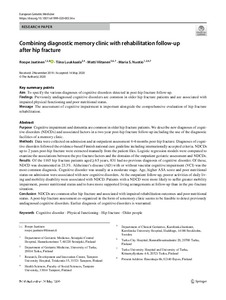Combining diagnostic memory clinic with rehabilitation follow-up after hip fracture
Nuotio Maria S.; Viitanen Matti; Jaatinen Roope; Luukkaala Tiina
https://urn.fi/URN:NBN:fi-fe2021042826901
Tiivistelmä
Purpose: Cognitive impairment and dementia are common in older hip fracture patients. We describe new diagnoses of cognitive disorders (NDCDs) and associated factors in a two-year post-hip fracture follow-up including the use of the diagnostic facilities of a memory clinic.
Methods: Data were collected on admission and at outpatient assessment 4–6 months post-hip fracture. Diagnoses of cognitive disorders followed the evidence-based Finnish national care guideline including internationally accepted criteria. NDCDs up to 2 years post-hip fracture were extracted manually from the patient files. Logistic regression models were computed to examine the associations between the pre-fracture factors and the domains of the outpatient geriatric assessment and NDCDs.
Results: Of the 1165 hip fracture patients aged ≥ 65 years, 831 had no previous diagnosis of cognitive disorder. Of these, NDCD was documented in 23.3%. Alzheimer’s disease (AD) with or without vascular cognitive impairment (VCI) was the most common diagnosis. Cognitive disorder was usually at a moderate stage. Age, higher ASA score and poor nutritional status on admission were associated with new cognitive disorders. At the outpatient follow-up, poorer activities of daily living and mobility disability were associated with NDCD. Patients with a NDCD were more likely to suffer greater mobility impairment, poorer nutritional status and to have more supported living arrangements at follow-up than in the pre-fracture situation.
Conclusion: NDCDs are common after hip fracture and associated with impaired rehabilitation outcomes and poor nutritional status. A post-hip fracture assessment co-organized in the form of a memory clinic seems to be feasible to detect previously undiagnosed cognitive disorders. Earlier diagnosis of cognitive disorders is warranted.
Kokoelmat
- Rinnakkaistallenteet [19207]
